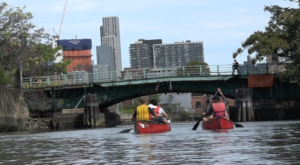The Gowanus Dredgers Canoe Club have been cleaning up the heavily polluted Gowanus canal for 19 years. Now, the imminent replacement of the canal’s most iconic bridge is putting the Gowanus Dredger’s vision for the canal in danger.
“Your planning should be inclusive of all users, not just people who happen to be using it today,” warns the Canoe Club’s treasurer, Owen Foote.
The Union Street Bridge was first installed over the Gowanus Canal in 1905. At the time, the canal welcomed thousands of ships per year for trade. This required the Union Street Bridge to be movable, with the ability to open and close when needed for oncoming ships. In 2012, Hurricane Sandy caused major damage to the bridge and six years on the New York City Department of Transportation has deemed it is time for replacement.
Today, the Gowanus Canal receives much less traffic than it had one hundred years ago and virtually no commercial traffic. The lack of large ships passing through remove the necessity for bridges above the canal to be movable. In accordance with today’s perceived needs, the New York City Department of Transportation has just started a solicitation for comment period to evaluate replacing the Union Street Bridge with a new, inoperable bridge. This new bridge will limit the types of vessels which can navigate the canal, restricting future use for commercial ships and taller recreational vessels like large sailboats.
Contributing to the decline of ship traffic in the Gowanus Canal is undoubtedly it’s pollution. The Gowanus Canal is notorious for its toxic water which is a result of years of pollution by factories and chemical plants along the canal. On the bottom of the canal, there are thick layers of what is known to locals as “black mayonnaise.” Black mayonnaise is a toxic combination of liquid tar, sewage, and chemicals.
On a recent canoe trip along the canal organized by Canoe Club, participants could be heard calling the filthy water “disgusting” at first sight and were visibly concerned about it inadvertantly splashing on their skin.
The Gowanus Dredgers Canoe Club is a local non-profit that is working to transform the canal. Every Wednesday and Saturday, the club provides canoes to the public so local Brooklynites and visitors can survey the pollution damage themselves and help the cause by collecting trash from the canal. Their efforts to restore health to the canal will be significantly bolstered by the EPA, which has designated the Gowanus Canal as a Superfund site. This designation will lead to the dredging of the canal, which is forecasted to begin at the end of September. The EPA claims they will be able to properly clean the canal within 10 years.
The Canoe Club believe that with the help of the EPA, a vibrant Gowanus Canal with a lively shoreline and an abundance of maritime activity can finally come to fruition. However, the replacement of the Union Street Bridge with a fixed bridge is a hindrance to their vision charging that the Department of Transportation is focusing too much on the present, rather than acknowledging the canal’s potential in the future.
“To do an evaluation of the canal and it’s use as of today as to justify a non-operable bridge is short-sighted,” argued Foote. “What we should be thinking of is when it is finally re-constructed in a decade or two, what then would the uses be?”
Foote, an architect himself, had just finished hosting a tour of the canal for a group of architecture students. Recounting the tour, Foote recalls “on today’s voyage, we saw a person with a sailboat parked on the Gowanus canal. On a clean Gowanus, there’ll be sailboats all over the place. How is a sailboat going to get through the Union Street Bridge if it doesn’t open anymore?”
The Canoe Club has just under 60 days to submit comments to the Department of Transportation regarding the construction of the new, fixed bridge. Foote and the other board members of the Gowanus Dredgers Canoe Club are currently drafting their response. Their expectations that it will coerce the DOT to make a new movable bridge are low as movable bridges are significantly more expensive to build and require more maintenance over the years.
Amid an uncertain future for the canal, the Canoe Club received a special visitor from London, England. Dhruv Boruah is an activist who has built his own water bicycle, which he’s been using to ride the world’s waterways for the last 18 months, picking up trash he sees along the way. The Thames Project, the title of his worldwide initiative, aims to “make everyone aware about the dangers of plastic pollution and inspire them to take action.”
Dhruv wants people to remember that water conservancy isn’t just a Gowanus issue, but a cause that has no borders and affects people from around the world. “It’s one planet, this Gowanus canal is a part of the same waterbody,” he said. “It links directly to the Ganges in India or the Amazon River, it’s all connected.”
Correction (October 17th, 2018): The article originally claimed “the New York City Department of Transportation has just announced that it will be replacing the Union Street Bridge with a new, fixed bridge” instead of the more accurate “the New York City Department of Transportation has just started a solicitation for comment period to evaluate replacing the Union Street Bridge with a new, inoperable bridge.”

